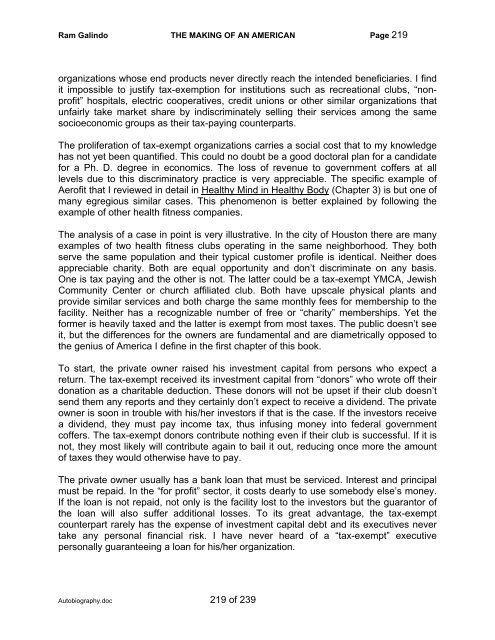Autobiography - The Galindo Group
Autobiography - The Galindo Group
Autobiography - The Galindo Group
You also want an ePaper? Increase the reach of your titles
YUMPU automatically turns print PDFs into web optimized ePapers that Google loves.
Ram <strong>Galindo</strong> THE MAKING OF AN AMERICAN Page 219<br />
organizations whose end products never directly reach the intended beneficiaries. I find<br />
it impossible to justify tax-exemption for institutions such as recreational clubs, “nonprofit”<br />
hospitals, electric cooperatives, credit unions or other similar organizations that<br />
unfairly take market share by indiscriminately selling their services among the same<br />
socioeconomic groups as their tax-paying counterparts.<br />
<strong>The</strong> proliferation of tax-exempt organizations carries a social cost that to my knowledge<br />
has not yet been quantified. This could no doubt be a good doctoral plan for a candidate<br />
for a Ph. D. degree in economics. <strong>The</strong> loss of revenue to government coffers at all<br />
levels due to this discriminatory practice is very appreciable. <strong>The</strong> specific example of<br />
Aerofit that I reviewed in detail in Healthy Mind in Healthy Body (Chapter 3) is but one of<br />
many egregious similar cases. This phenomenon is better explained by following the<br />
example of other health fitness companies.<br />
<strong>The</strong> analysis of a case in point is very illustrative. In the city of Houston there are many<br />
examples of two health fitness clubs operating in the same neighborhood. <strong>The</strong>y both<br />
serve the same population and their typical customer profile is identical. Neither does<br />
appreciable charity. Both are equal opportunity and don’t discriminate on any basis.<br />
One is tax paying and the other is not. <strong>The</strong> latter could be a tax-exempt YMCA, Jewish<br />
Community Center or church affiliated club. Both have upscale physical plants and<br />
provide similar services and both charge the same monthly fees for membership to the<br />
facility. Neither has a recognizable number of free or “charity” memberships. Yet the<br />
former is heavily taxed and the latter is exempt from most taxes. <strong>The</strong> public doesn’t see<br />
it, but the differences for the owners are fundamental and are diametrically opposed to<br />
the genius of America I define in the first chapter of this book.<br />
To start, the private owner raised his investment capital from persons who expect a<br />
return. <strong>The</strong> tax-exempt received its investment capital from “donors” who wrote off their<br />
donation as a charitable deduction. <strong>The</strong>se donors will not be upset if their club doesn’t<br />
send them any reports and they certainly don’t expect to receive a dividend. <strong>The</strong> private<br />
owner is soon in trouble with his/her investors if that is the case. If the investors receive<br />
a dividend, they must pay income tax, thus infusing money into federal government<br />
coffers. <strong>The</strong> tax-exempt donors contribute nothing even if their club is successful. If it is<br />
not, they most likely will contribute again to bail it out, reducing once more the amount<br />
of taxes they would otherwise have to pay.<br />
<strong>The</strong> private owner usually has a bank loan that must be serviced. Interest and principal<br />
must be repaid. In the “for profit” sector, it costs dearly to use somebody else’s money.<br />
If the loan is not repaid, not only is the facility lost to the investors but the guarantor of<br />
the loan will also suffer additional losses. To its great advantage, the tax-exempt<br />
counterpart rarely has the expense of investment capital debt and its executives never<br />
take any personal financial risk. I have never heard of a “tax-exempt” executive<br />
personally guaranteeing a loan for his/her organization.<br />
<strong>Autobiography</strong>.doc 219 of 239


